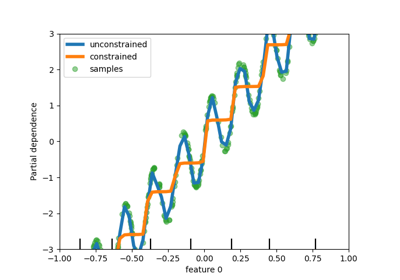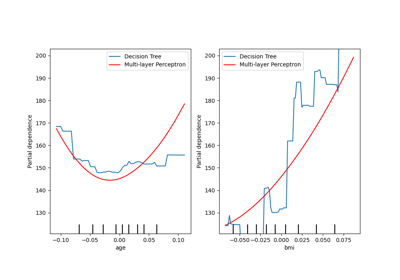Note
Go to the end to download the full example code. or to run this example in your browser via Binder
单调约束#
这个例子说明了单调约束对梯度提升估计器的影响。
我们构建了一个人工数据集,其中目标值通常与第一个特征正相关(带有一些随机和非随机的变化), 并且通常与第二个特征负相关。
通过在学习过程中分别对特征施加单调增加或单调减少的约束,估计器能够正确地遵循总体趋势, 而不是受到变化的影响。
这个例子灵感来自于 XGBoost 文档 。
import matplotlib.pyplot as plt
import numpy as np
from sklearn.ensemble import HistGradientBoostingRegressor
from sklearn.inspection import PartialDependenceDisplay
rng = np.random.RandomState(0)
n_samples = 1000
f_0 = rng.rand(n_samples)
f_1 = rng.rand(n_samples)
X = np.c_[f_0, f_1]
noise = rng.normal(loc=0.0, scale=0.01, size=n_samples)
# y 与 f_0 正相关,与 f_1 负相关
y = 5 * f_0 + np.sin(10 * np.pi * f_0) - 5 * f_1 - np.cos(10 * np.pi * f_1) + noise
在此数据集上拟合第一个没有任何约束的模型。
gbdt_no_cst = HistGradientBoostingRegressor()
gbdt_no_cst.fit(X, y)
在此数据集上分别拟合一个具有单调增加(1)和单调减少(-1)约束的第二模型。
gbdt_with_monotonic_cst = HistGradientBoostingRegressor(monotonic_cst=[1, -1])
gbdt_with_monotonic_cst.fit(X, y)
让我们展示预测结果对这两个特征的部分依赖性。
fig, ax = plt.subplots()
disp = PartialDependenceDisplay.from_estimator(
gbdt_no_cst,
X,
features=[0, 1],
feature_names=(
"First feature",
"Second feature",
),
line_kw={"linewidth": 4, "label": "unconstrained", "color": "tab:blue"},
ax=ax,
)
PartialDependenceDisplay.from_estimator(
gbdt_with_monotonic_cst,
X,
features=[0, 1],
line_kw={"linewidth": 4, "label": "constrained", "color": "tab:orange"},
ax=disp.axes_,
)
for f_idx in (0, 1):
disp.axes_[0, f_idx].plot(
X[:, f_idx], y, "o", alpha=0.3, zorder=-1, color="tab:green"
)
disp.axes_[0, f_idx].set_ylim(-6, 6)
plt.legend()
fig.suptitle("Monotonic constraints effect on partial dependences")
plt.show()

我们可以看到,无约束模型的预测捕捉到了数据的波动,而约束模型则遵循总体趋势,忽略了局部变化。
使用特征名称指定单调约束
请注意,如果训练数据具有特征名称,可以通过传递字典来指定单调约束:
import pandas as pd
X_df = pd.DataFrame(X, columns=["f_0", "f_1"])
gbdt_with_monotonic_cst_df = HistGradientBoostingRegressor(
monotonic_cst={"f_0": 1, "f_1": -1}
).fit(X_df, y)
np.allclose(
gbdt_with_monotonic_cst_df.predict(X_df), gbdt_with_monotonic_cst.predict(X)
)
True
Total running time of the script: (0 minutes 0.562 seconds)
Related examples




